Family : Sphyrnidae

Text © Giuseppe Mazza

English translation by Mario Beltramini
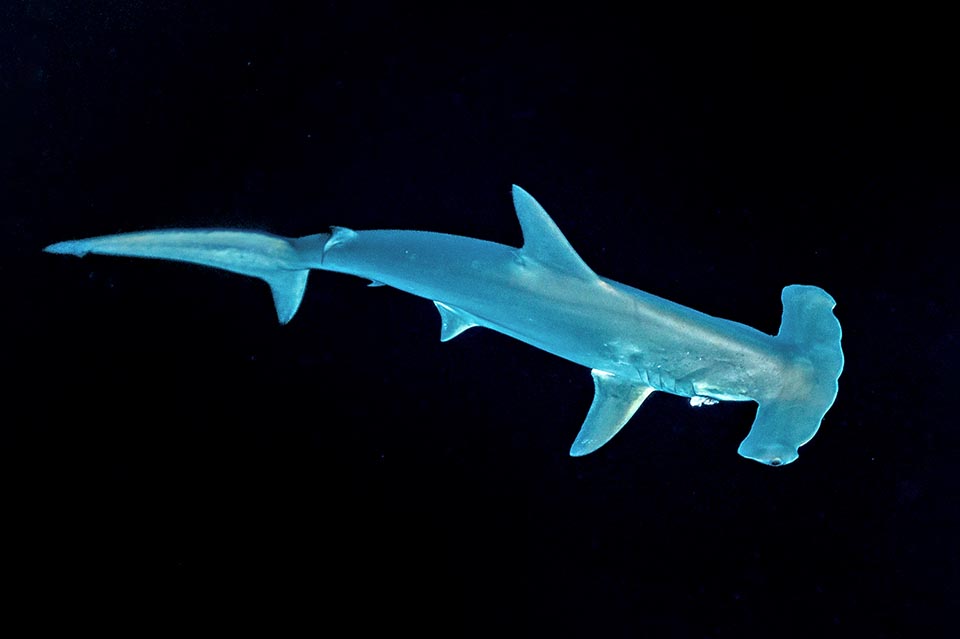
Highly endangered species, the Scalloped hammerhead shark (Sphyrna lewini) lives in the whole world tropical and warm temperate seas, Mediterranean included © Allison & Carlos Estape
Known as Scalloped hammerhead or Hammerhead shark, Sphyrna lewini (Griffith & Smith, 1834) belongs to the class of the Chondrichthyes, the cartilaginous fishes, to the order of the Carcharhiniformes, the richest in the world of the sharks with more than 270 species and to the family of the Sphyrnidae grouping 10 fishes having the head enlarged on the sides like a hammer to increase the sensory abilities.
The name of the genus Sphyrna originates then, not by a chance, from the old Greek “σφῦρα” (sphyrna) = hammer, whilst the specific term lewini, of Lewin in Latin, recalls the English naturalist painter John William Lewin (1771-1819) who moved to Australia in 1800 for documenting with his watercolours the local fauna and flora.
Conversely, the common term scalloped refers to the profile of the snout with alternating protrusions and indentations.
Zoogeography
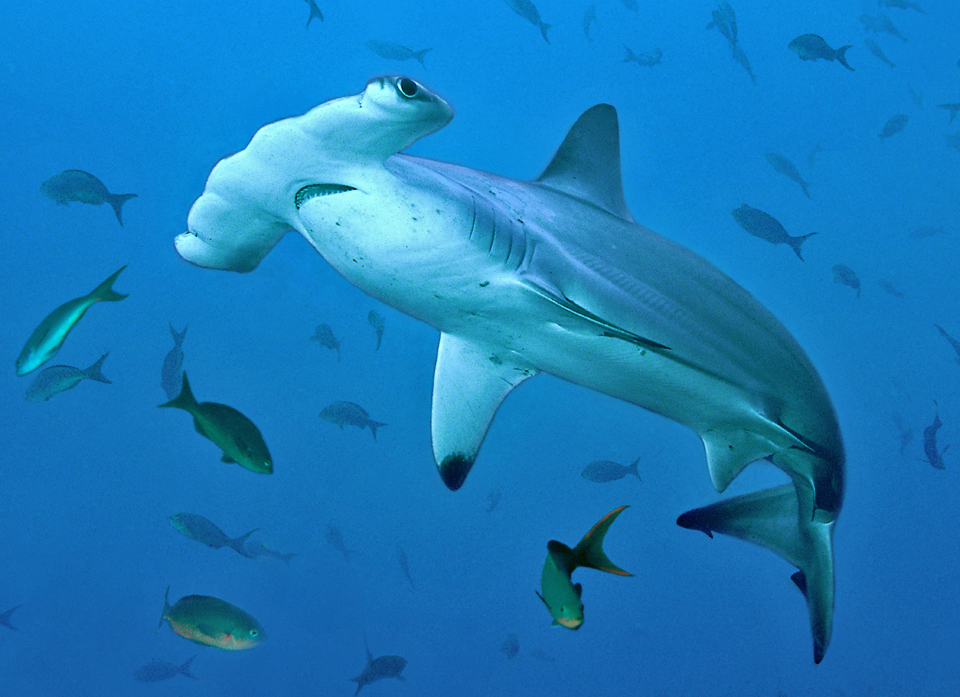
It may exceed the length of 4 m and 150 kg. It has flat snout with fore margin scalloped by a marked central recess and by other two ones on the sides © Richard Merrit
Sphyrna lewini goes swimming in the tropical and warm temperate waters of all the world, Mediterranean included. In the northern hemisphere, it reaches the Bermuda Islands, USA, the French coasts and Japan, whilst in the southern hemisphere it goes up to Uruguay, Argentina, South Africa and Australia. Because of its enormous range, are locally known, like, for instance, on both sides of the Atlantic, forms defined as “cryptic”, apparently identical, but with a different genetic heritage.
Ecology-Habitat
The Scalloped hammerhead shark usually swims along the coasts often hunting in very numerous schools between the surface and 25 m of depth, even if it has been filmed around the 500 m and it seems it can go down up to 1000 m.
It loves the reefs and the bays but often also enters the brackish waters of the estuaries.
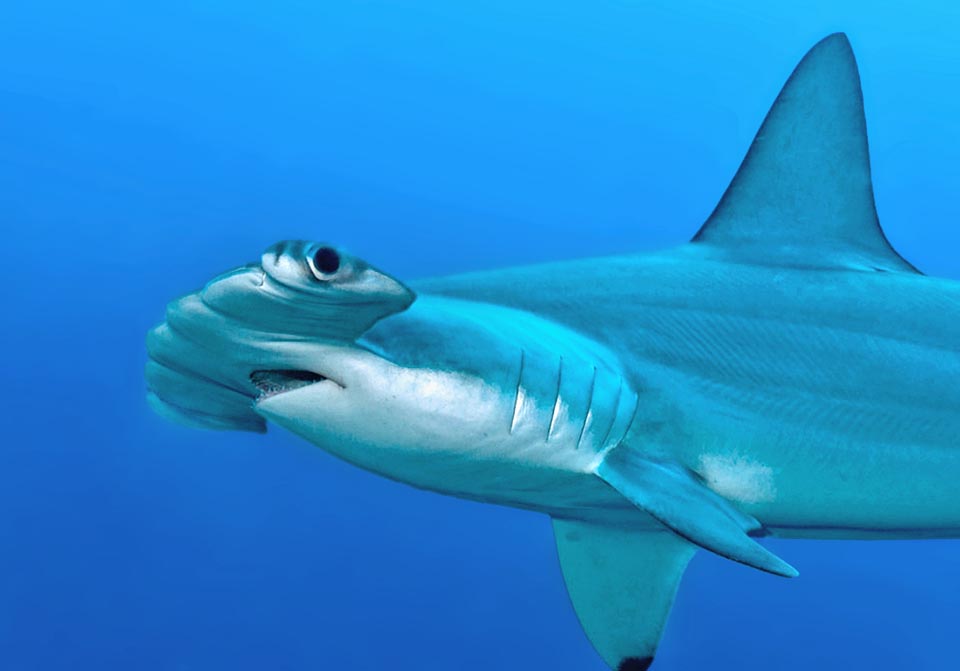
The eyes, more distant than the other sharks, allow a better global stereoscopic vision for evaluating distances for the attack. The olfactory sense perceives dilutions up to one millionth of the blood present in the water and the flat shape of the snout emphasizes the sensitivity to the magnetic fields of the Ampullae of Lorenzini © Susana Martin
Some populations are permanent residents of the continental or insular platforms, others carry out mass migrations. The females often swim in groups and the males, solitary at times, gather for reproduction. We note a social behaviour in the schools with dominant subjects and a hierarchy based on a complex language based on contacts head-to-head, movements of the mouth and sudden accelerations.
Morphophysiology
There is a documented record of 4,3 m of length and of 152,4 kg, but the usual size is about 3,6 m. The body is moderately slender and the characteristic flat head, enlarged on the sides, displays a scalloped fore margin from a central pronounced indentation and two more on the sides. On the apex stand the eyes, equipped with a solid nictitating membrane to protect them from the reactions of the victims, and large nostrils preceded by a groove that conveys the water to the olfactory cells, so much sensitive to perceive dilutions up to one millionth of the blood present in the water.
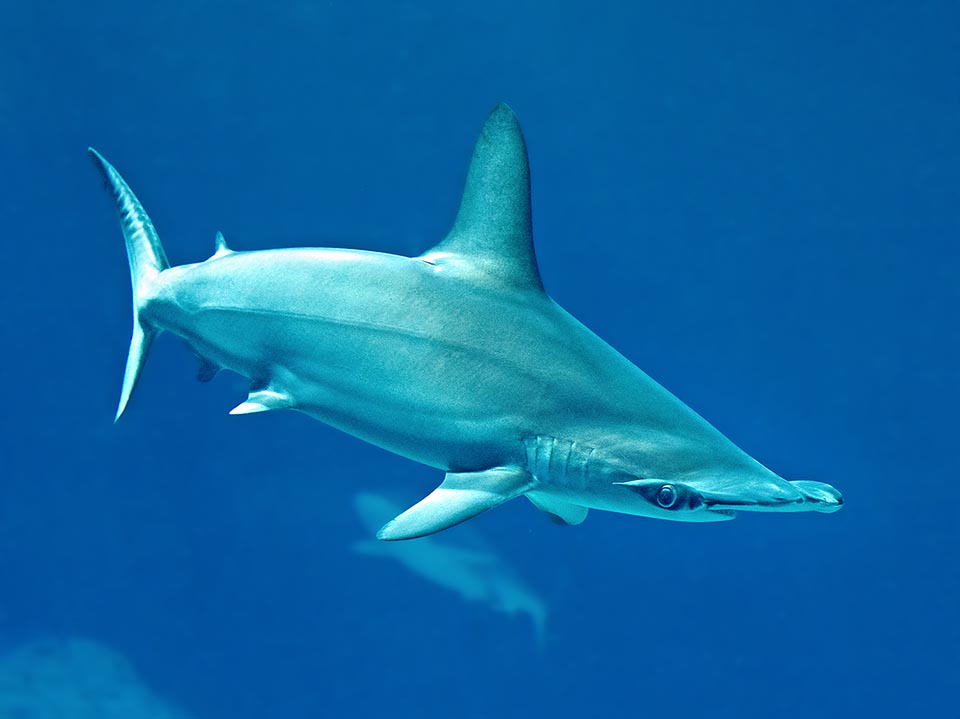
These detect those emitted by the hidden preys and the lateral line, well visible here, gets their movements © Giuseppe Mazza
Its eyesight is excellent. It was thought that in such a position the eyes did not have a good binocular vision, but recent tests have proven that, conversely, their field of view is excellent in any direction with a global stereoscopic view allowing it to well evaluate the distances for carrying out targeted attacks.
But the sense organs of this species that often goes hunting during the night do not stop at the eyesight and the sense of smell, because the Ampullae of Lorenzini, visible outside as pores on the head detect with extreme precision the magnetic field emitted by the hidden preys and memorize the places where they swim through the Earth’s magnetic field to find them again, when needed, with the precision of a GPS. This sense organ is present also in other sharks but here the flat size of the snout, like a radar, emphasizes it with surprising results.
The mouth is arched with 15-16 smooth or slightly serrated triangular teeth on each side of the jaws. The lower ones are bent inwards to hold the prey.
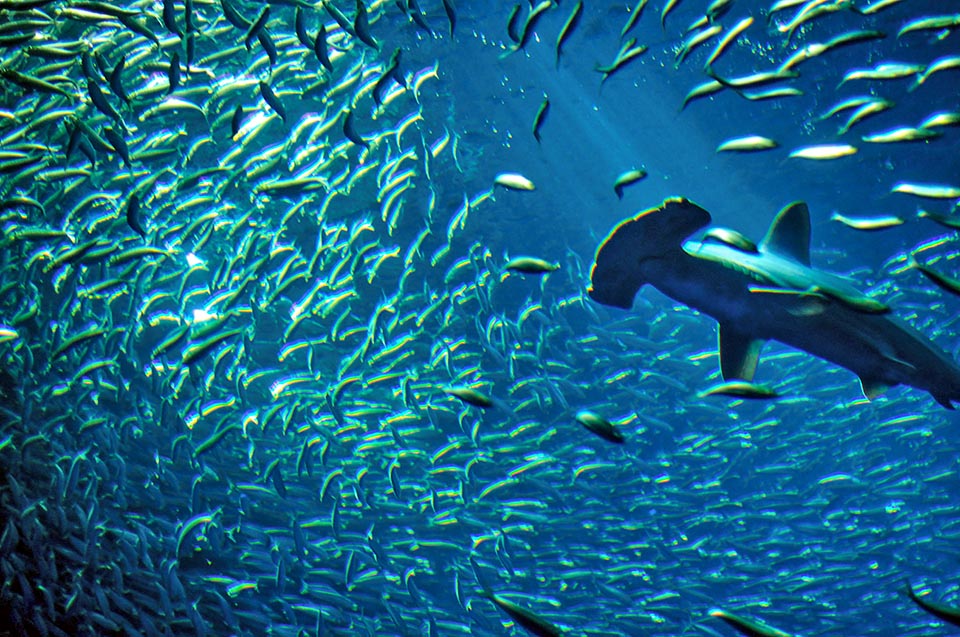
Scalloped hammerhead shark eats usually bony fishes living in schools, like sardines, herrings and mackerels, but also bigger prey the size of barracudas and cartilaginous fishes with predilection for rays. It also attacks small sharks and makes slaughters in the squid’s schools, not forgetting possible octopuses and lobsters © Jeff Olshan
The gill openings are five, the fourth and the fifth stand at the junction of the pectoral fins that are wide and relatively short with a showy black spot at the apex on the lower side.
The first dorsal fin is high and wide. The second, smaller than the anal, presents an odd, pointed back appendage, longer than the base of the fin. The ventral ones, located close to the copulatory clasper in the males, are modest. The caudal fin is asymmetrical due to the very long asymmetrical upper lobe with a pronounced sub-apical notch. It is the driving force of the fish that can also advance like “a corkscrew” with an unusual, twisted swim.
The skin is protected by tiny, keeled sales to reduce the friction with the water. The upper part of the body is pale grey or greyish brown and as usual the ventral side is whitish, to escape from sight of the preys from above as it imitates the sea beds as well as from below as it blends in with the brightness of the sea.
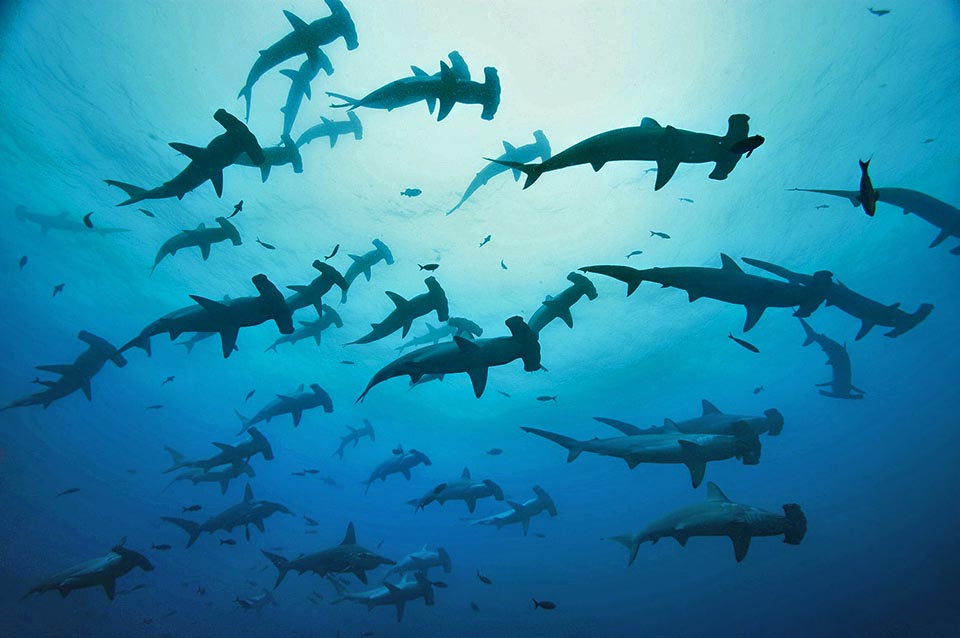
In the schools there is a social behaviour with hierarchy based on a complex language made by head-to-head bumps, movements of the mouth and sudden accelerations © Eric Cheng-echengphoto.com
Ethology-Reproductive Biology
Sphyrna lewini mainly eats bony fishes, such as sardines, herrings and mackerels, but also bigger preys like the barracudas and the groupers. Among the cartilaginous fishes it loves the rays but attacks also small sharks and, in its menu, often appear squids, octopuses and lobsters, to which add, especially when young, shrimps and crabs.
Though potentially dangerous, the Scalloped hammerhead shark usually does not attack man. According to the statistics of “Shark Attack File”, in Florida the unprovoked attacks are decidedly few and the deaths are very rare.
The females of the Scalloped hammerhead shark reach the sexual maturity starting from the length of 2 m, in the male somewhat before, at times already when 1,4 m long. Mating, preceded by a ritual swim of the male, takes place, as usually occurs in the sharks, by holding with the teeth the pectoral fins of the female during the fecundation.
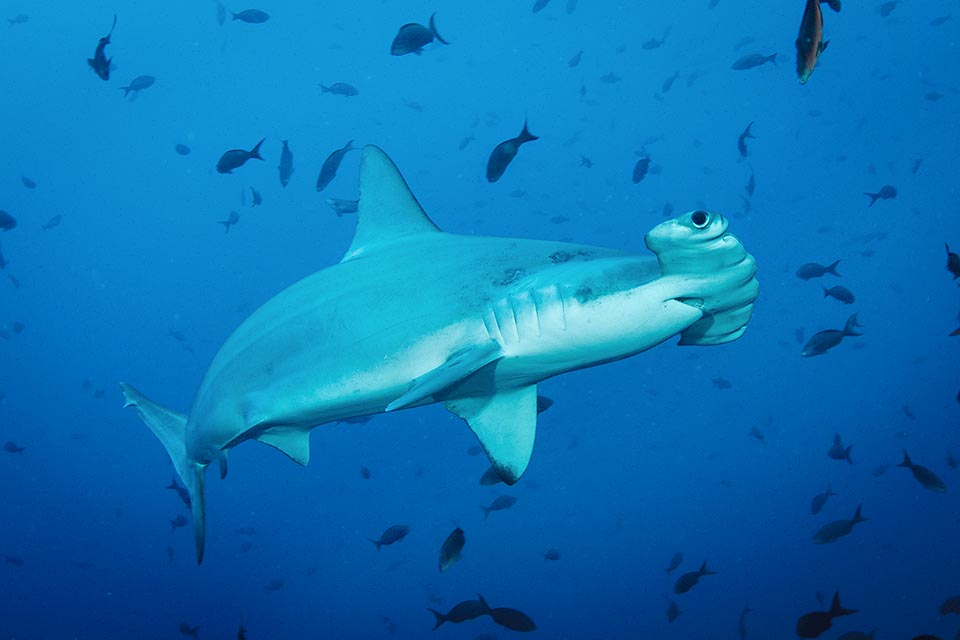
After fecundation the larvae grow up initially consuming the yolk sac of the egg, but then this turns into placenta and carries the blood of the mother. It is therefore a viviparous species, with females that after a gestation of 9-10 months deliver generally 15-31 pups, about 40-55 cm long and already self-sufficient © Steve Wiliams
The incubation takes place in the maternal womb. The larvae grow up consuming the yolk sac of the egg but later this transform in placenta conveying the mother’s blood. It is therefore a viviparous species.
For delivery, after a gestation of 9-10 months, the females move into shallow waters, often towards the formations of mangroves where the food abounds, and the pups can grow between the roots safe from the large predators. They mainly deliver 15-31 pups, a high number if compared to the other sharks, because during the first times the death rate is very high.
Upon birth, they are about 40-55 cm long, then the skin gets darker to camouflage and protect from the sun. After the three years, they have a life expectancy of about 30 years.
The attempt to acclimatize them in the oceanic pools of the big public aquaria has not been very successful: the adults die quickly and the young don’t survive for long.
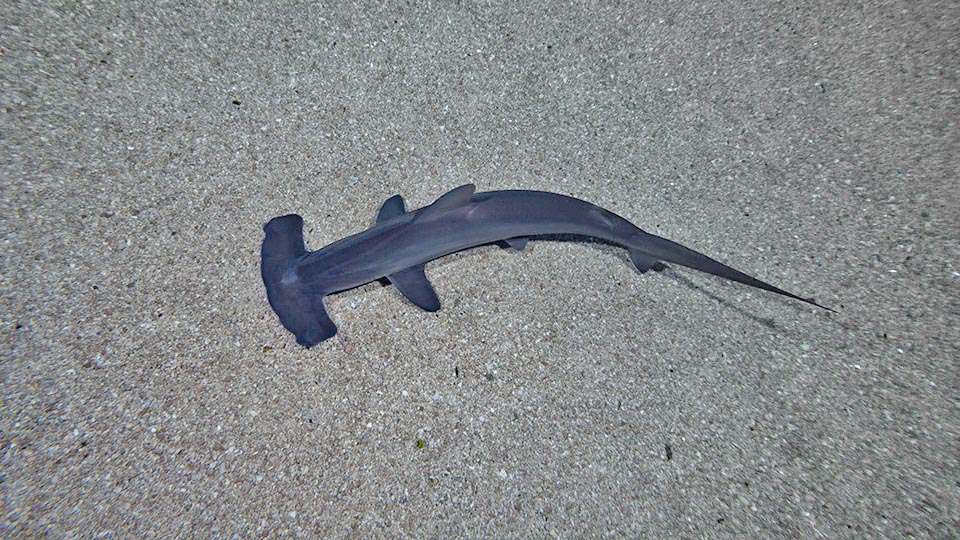
While growing the young’s skin darkens. This has already learnt to use the Ampoulae of Lorenzini and looks for magnetic fields of possible preys hidden under the sand © www.davidfleetham.com
Even if the flesh is not suitable for the consumption due to the accumulation of the poisons present in the preys, the Scalloped hammerhead shark is under threat from industrial fishing for the cartilages rich on calcium and the squalamine present in the liver, a molecule used for pharmaceutical products integrative for various pathologies with anticancer properties. The carcass turns into fishmeal. When they get into the nets, the local fishermen are interested only in the fins as they have a certain economical value, and in order not to clutter the boat, many specimens are thrown back to the sea still alive after this cruel maiming.
Nowadays, in 2022, the resilience of Sphyrna lewini is low as is needed more than 4,5-14 years for doubling the populations decimated by the events, and the vulnerability to fishing index, very high, already marks 78 on a scale of 100. The Scalloped hammerhead shark consequently appears in the Red List of the endangered species as “Critically Endangered”, that is under great risk. This is the voice that precedes the box “extinct”.
Synonyms
Zygaena lewini Griffith & Smith, 1834; Zygaena indica van Hasselt, 1823; Cestracion leeuwenii Day, 1865; Zygaena erythraea Klunzinger, 1871; Cestracion oceanica Garman, 1913; Sphyrna diplana Springer, 1941.
→ For general information about FISH please click here.
→ For general information about CARTILAGINOUS FISH please click here.
→ For general information about BONY FISH please click here
→ To appreciate the BIODIVERSITY of CARTILAGINOUS FISH please click here.
→ To appreciate the BIODIVERSITY of BONY FISH please click here.
